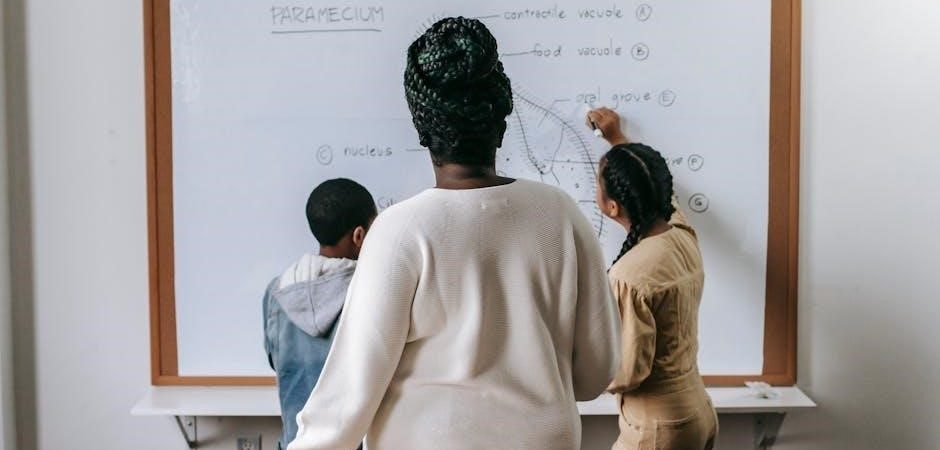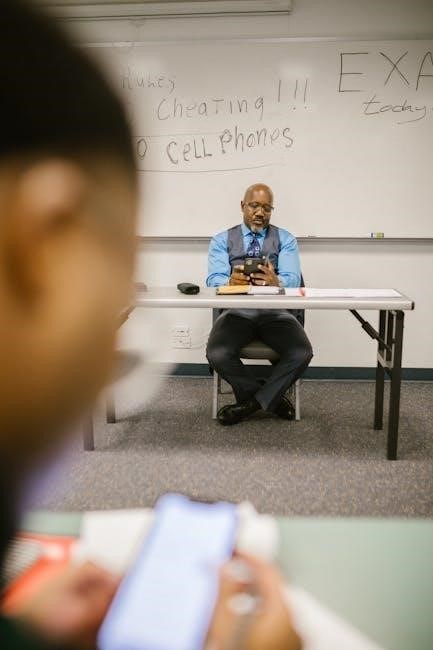
Instructional fundamentals form the cornerstone of effective teaching, encompassing core principles that guide instructors in creating engaging, structured lessons. This section explores the essential concepts and methodologies that ensure successful knowledge transfer, fostering a productive learning environment for students. By mastering these foundational elements, educators can develop well-organized lesson plans, communicate clearly, and assess student progress effectively, ensuring a comprehensive understanding of the subject matter.
1.1. Definition and Importance of Instructional Fundamentals
Instructional fundamentals refer to the core principles and methodologies that guide effective teaching and learning processes. These foundational elements ensure that instructors can deliver structured, engaging lessons while addressing diverse student needs. The importance lies in their universal application across various educational settings, from aviation to academic environments. By mastering these fundamentals, educators can create well-organized lesson plans, employ effective communication strategies, and assess student progress accurately. These principles also emphasize the psychological aspects of learning, ensuring instructors understand student behavior and adapt their approaches accordingly. Ultimately, instructional fundamentals provide a framework for creating a productive and inclusive learning environment, fostering academic success and skill development. They are essential for both new and experienced educators aiming to enhance their teaching efficacy.
1.2. Overview of the Fundamentals of Instruction Study Guide
The Fundamentals of Instruction Study Guide is a comprehensive resource designed to equip educators with essential teaching skills and knowledge. It covers core principles such as lesson planning, communication strategies, and assessment techniques, providing a structured approach to effective instruction. The guide emphasizes understanding student behavior, leveraging psychological insights to create engaging learning environments. Additionally, it addresses the importance of adaptability and clarity in teaching methods, ensuring instructors can meet diverse learner needs. This study guide serves as a valuable tool for both new and experienced educators, offering practical strategies to enhance teaching efficacy and promote student success across various educational settings.

Human Behavior in Instructional Settings
Understanding human behavior in instructional settings is crucial for effective teaching. It involves analyzing psychological factors, learning styles, and social interactions to create an optimal learning environment.
2.1. Understanding Student Behavior and Needs

Understanding student behavior and needs is vital for effective instruction. Instructors must recognize diverse learning styles, prior knowledge, and motivational factors. By assessing individual differences, educators can tailor strategies to meet unique requirements, fostering engagement and progress. This involves creating a supportive environment that addresses emotional, social, and cognitive aspects of learning. Recognizing these elements ensures personalized instruction, helping students achieve their full potential. Additionally, understanding human behavior enables instructors to adapt their methods, ensuring relevance and effectiveness in various instructional settings. This foundation is crucial for aligning teaching practices with student needs, promoting active participation and successful outcomes. The internet content highlights the importance of flexibility and adaptability in lesson planning to accommodate these factors.
2.2. The Role of Psychology in Instruction
Psychology plays a pivotal role in shaping instructional strategies by providing insights into how students learn and engage. Understanding psychological principles, such as motivation, cognitive development, and emotional factors, enables instructors to create a supportive and effective learning environment. By applying theories like Bloom’s Taxonomy, educators can align teaching methods with student needs, fostering deeper understanding and retention. Psychology also helps instructors recognize individual differences, adapt teaching approaches, and promote active participation. This knowledge ensures that lessons are tailored to enhance engagement, address diverse learning styles, and cater to the emotional and cognitive needs of students, ultimately improving overall instructional effectiveness and student outcomes.

The Learning Process
The learning process involves stages of absorption, processing, and retention of information. It is influenced by factors like motivation, environment, and prior experiences. Understanding these elements helps educators develop effective instructional strategies.
3.1. Key Stages of Learning
The learning process is divided into distinct stages that ensure effective knowledge acquisition. The first stage is engagement, where students show interest and readiness to learn. Next is acquisition, where new information is introduced and understood. This is followed by application, where students use the knowledge in practical scenarios. Finally, assessment evaluates understanding, and retention ensures long-term memory of the material. These stages are crucial for creating structured lesson plans that cater to diverse learning needs, ensuring that students progress from awareness to mastery of the subject matter effectively.
3.2. Factors Influencing the Learning Process
The learning process is shaped by various factors, including individual differences, such as prior knowledge and motivation, which significantly impact how students absorb information. The learning environment also plays a critical role, with elements like classroom setup and technology influencing engagement and focus. Additionally, the instructor’s teaching style, communication skills, and ability to adapt to student needs are essential. External factors, such as personal experiences and societal influences, further shape learning outcomes. Understanding these factors allows educators to tailor their methods, ensuring a more personalized and effective learning experience for all students, regardless of their background or circumstances.
Effective Communication in Instruction
Effective communication is vital for successful instruction, involving clear verbal and non-verbal techniques to engage students and convey ideas. Clarity, active listening, and constructive feedback are essential.
4.1. Verbal and Non-Verbal Communication Techniques
Effective communication in instruction relies on both verbal and non-verbal techniques to convey ideas clearly and engage students. Verbal communication involves clear speech, appropriate tone, and pacing to ensure understanding. Non-verbal cues, such as gestures, facial expressions, and eye contact, reinforce messages and build rapport. Active listening and feedback are critical, allowing instructors to gauge student comprehension and adjust their teaching strategies. Consistency in communication helps maintain a structured learning environment, while adaptability ensures messages resonate with diverse learners. By mastering these techniques, instructors can create a supportive and interactive classroom atmosphere, fostering student engagement and academic success.
4.2. Active Listening and Feedback in Teaching
Active listening and constructive feedback are vital for effective instruction, fostering a supportive learning environment. Instructors must fully engage with students, maintaining eye contact and avoiding interruptions to ensure understanding. Paraphrasing and asking clarifying questions can confirm comprehension and encourage deeper thinking. Feedback should be specific, timely, and actionable, highlighting strengths and areas for improvement. Positive reinforcement builds confidence, while constructive criticism guides growth. Instructors should also encourage peer feedback, promoting collaborative learning and mutual respect. By actively listening and providing thoughtful feedback, educators can address individual needs, enhance student performance, and cultivate a culture of continuous improvement in the classroom.

The Teaching Process
The teaching process is a systematic approach to lesson planning, delivering instruction, and assessing student learning. It involves creating engaging activities, using effective strategies, and continuously improving instructional methods to meet student needs and achieve learning objectives.
5.1. Lesson Planning and Preparation
Lesson planning is a critical component of effective instruction, ensuring that educational objectives are met. A well-planned lesson includes clear learning goals, organized content, and engaging activities tailored to student needs. Instructors must align lessons with broader curriculum goals while incorporating flexibility to adapt to classroom dynamics. Preparation involves selecting appropriate materials, assessing student readiness, and anticipating potential challenges. The teaching process begins with this foundational step, as a structured plan guides the delivery of instruction. Effective lesson planning promotes active learning, fosters student engagement, and ensures that instructors cover all necessary topics efficiently. It also allows for the integration of various instructional strategies to cater to diverse learning styles, enhancing overall educational outcomes.
5.2. Instructional Activities and Strategies
Effective instructional activities and strategies are essential for engaging students and promoting active learning. These include lectures, discussions, group activities, and hands-on exercises, each tailored to specific learning objectives. Instructors should employ a variety of methods to cater to different learning styles, such as visual, auditory, and kinesthetic approaches. Incorporating real-world examples and case studies can enhance understanding and application of concepts. Technology integration, such as multimedia presentations and interactive tools, can also enrich the learning experience. The key is to create a dynamic and inclusive environment that encourages participation and critical thinking. By aligning activities with lesson goals, instructors can ensure that students achieve the desired outcomes and develop practical skills.

5.3. Assessment and Evaluation Techniques
Assessment and evaluation are crucial for measuring student understanding and instructional effectiveness. Instructors use various techniques, such as quizzes, exams, and performance tasks, to gauge learning outcomes. Formative assessments, like class discussions and homework, provide ongoing feedback, while summative assessments, such as final exams, evaluate overall mastery. Diagnostic assessments identify students’ strengths and weaknesses, guiding targeted instruction. Technology-enhanced tools, such as online quizzes and interactive simulations, offer innovative ways to assess knowledge. Clear rubrics and consistent grading practices ensure fairness and transparency. By aligning assessments with learning objectives, instructors can accurately evaluate student progress and adjust teaching strategies to enhance outcomes. Regular feedback helps students refine their understanding and skills, fostering continuous improvement.

Instructor Responsibilities and Professional Development
Instructors are responsible for lesson planning, classroom management, and fostering a conducive learning environment. Continuous professional development ensures they stay updated on best practices, enhancing their teaching effectiveness.
6.1. Roles and Responsibilities of an Effective Instructor
An effective instructor plays a pivotal role in shaping the learning experience, ensuring students achieve their educational goals. Key responsibilities include lesson planning, delivering instruction, and assessing student progress. Instructors must create a supportive learning environment, fostering engagement and motivation. They should possess strong communication skills to convey complex concepts clearly and adapt teaching methods to meet diverse student needs. Additionally, instructors are responsible for classroom management, maintaining discipline, and promoting a positive atmosphere. They must stay updated on subject matter and instructional strategies to provide relevant, high-quality education. Continuous professional development is essential to refine teaching skills and address evolving educational demands, ensuring they remain effective in their roles.
6.2. Classroom Management and Leadership
Effective classroom management and leadership are critical for creating a structured, respectful, and productive learning environment. Instructors must establish clear expectations, rules, and consequences to ensure student engagement and minimize disruptions. Strong leadership involves fostering a positive classroom atmosphere, where students feel safe, motivated, and encouraged to participate. Instructors should employ active listening, positive reinforcement, and conflict resolution strategies to maintain order and address challenges promptly. Leadership also entails modeling professionalism, empathy, and adaptability, ensuring that diverse student needs are met. By combining clear communication with consistent enforcement of expectations, instructors can create an environment conducive to learning, where students thrive academically and socially. This balance ensures a well-managed classroom that supports both individual and collective success.
6.3. Continuous Professional Growth for Instructors
Continuous professional growth is essential for instructors to remain effective and adapt to evolving educational demands. Staying updated with new teaching methodologies, technologies, and subject matter ensures instructors deliver relevant and engaging lessons. Professional development opportunities, such as workshops, seminars, and online courses, provide instructors with tools to refine their skills. Resources like study guides, manuals, and instructional aids further support their growth. Engaging in reflective practices and seeking feedback helps instructors identify areas for improvement. By committing to lifelong learning, instructors enhance their expertise, fostering a more dynamic and effective learning environment for their students. This ongoing development ensures they remain competent and innovative in their teaching practices.

Lesson Planning and Delivery
Effective lesson planning and delivery are cornerstones of successful instruction. Instructors must craft well-structured plans, use diverse instructional methods, and adapt to student needs, ensuring engaging and efficient learning experiences.
7.1. Characteristics of a Well-Planned Lesson
A well-planned lesson is structured, clear, and aligned with learning objectives, ensuring coherence and focus. It begins with specific goals, outlining what students will achieve. The content is organized logically, with sequential activities that build on prior knowledge. Flexibility is key, allowing adjustments based on student responses. Instructional strategies are varied to engage different learning styles, and assessments are integrated to monitor progress. Clear instructions and materials support understanding, while opportunities for practice reinforce concepts. Effective lessons also include time for feedback and reflection, fostering a meaningful learning experience. These characteristics ensure that lessons are purposeful, engaging, and tailored to meet the diverse needs of students, ultimately enhancing their academic success.
7.2. Delivering Instruction Effectively
Delivering instruction effectively requires a combination of clear communication, engagement, and adaptability. Instructors should use verbal and non-verbal cues to ensure clarity, while actively listening to students to address their needs. Encouraging participation through questions, discussions, and hands-on activities fosters an interactive learning environment. Incorporating visual aids and real-world examples enhances understanding and retention. Timing and pacing are critical, ensuring all students can follow without feeling rushed or bored. Feedback is essential, providing constructive insights to guide improvement. Adapting teaching methods to diverse learning styles and abilities ensures inclusivity. Effective delivery also involves maintaining a positive and respectful classroom atmosphere, promoting motivation and focus. These strategies collectively enhance the learning experience, ensuring students achieve their full potential.

Assessment and Evaluation
Assessment and evaluation are crucial for measuring student progress, understanding, and application of knowledge. They provide insights to refine teaching strategies and improve learning outcomes effectively.
8.1. Types of Assessments in Instructional Settings
In instructional settings, assessments are categorized into various types to evaluate student learning effectively. Formative assessments, such as quizzes and class discussions, monitor progress during the learning process. Summative assessments, like final exams and projects, measure outcomes at the end of a lesson or course. Oral assessments involve verbal presentations, while written assessments include essays and multiple-choice tests. Performance-based assessments evaluate practical skills through tasks like lab experiments or simulations. Each type serves a distinct purpose, ensuring comprehensive evaluation of knowledge retention, application, and critical thinking. Understanding these types allows instructors to select appropriate tools for accurate and meaningful student evaluation.
8.2. Using Assessment Results to Improve Learning
Assessment results are crucial for refining instructional strategies and enhancing student learning outcomes. By analyzing data from quizzes, exams, and other evaluations, instructors can identify knowledge gaps and adjust teaching methods accordingly. Feedback from assessments helps students understand their progress and areas needing improvement. Instructors can use these insights to modify lesson plans, incorporate additional resources, and tailor activities to meet student needs. This data-driven approach ensures personalized learning experiences, fostering engagement and academic growth. Ultimately, leveraging assessment results promotes a cycle of continuous improvement, benefiting both students and educators in achieving educational goals effectively.

Professional Development for Instructors
Professional development is essential for instructors to enhance teaching skills and stay updated on educational trends. Continuous learning ensures instructors deliver effective instruction and support student success.
9.1. Importance of Ongoing Training for Instructors
Ongoing training is crucial for instructors to maintain and improve their teaching effectiveness. It helps them stay updated on the latest educational methods, technologies, and industry developments, ensuring they can adapt to changing student needs and diverse learning environments. Continuous professional development fosters a culture of excellence, enabling instructors to refine their skills in lesson planning, communication, and assessment. Additionally, it equips them with strategies to manage classrooms effectively and address various learning challenges. By prioritizing ongoing training, instructors can enhance student outcomes, stay relevant in their field, and contribute to the broader educational community. This commitment to growth ensures high-quality instruction and supports lifelong learning for both educators and their students.
9.2. Resources for Instructor Development
Various resources are available to support instructor development, ensuring educators can enhance their teaching skills and stay updated on best practices. Study guides, online courses, and workshops provide structured learning opportunities, while educational journals and publications offer insights into cutting-edge teaching methodologies. Professional organizations often host seminars and webinars, catering to specific instructional needs. Additionally, institutions may offer mentorship programs, pairing experienced instructors with newcomers to foster growth; These resources cover topics such as lesson planning, communication strategies, and classroom management, enabling instructors to adapt to diverse learning environments and student needs. Leveraging these tools ensures continuous improvement and excellence in teaching, benefiting both instructors and their students.